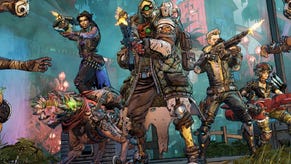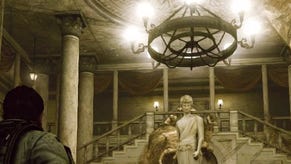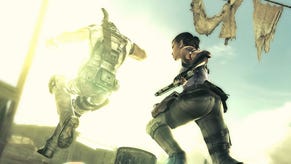Face-Off: Resident Evil 6
S.T.A.R.S. in their eyes.
| - | Xbox 360 | PlayStation 3 |
|---|---|---|
| Disc Size | 7.7GB | 10.1GB |
| Install | 7.7GB (optional) | 2642MB |
| Surround Support | Dolby Digital | Dolby Digital, 5.1LPCM |
Capcom's ambitions for Resident Evil 6 are lofty indeed: this new game is considerably bigger, faster-paced and more intense than previous instalments with the focus on survival horror toned down in favour of action-packed gunplay and blockbuster-style set-pieces. The firm's spruced-up MT Framework engine is well suited to delivering such spectacle on-screen, with the revised deferred lighting system - first showcased in Dragon's Dogma - giving the game a phenomenal atmosphere and upgraded physics powering a supremely effective destructible scenery implementation.
However, the change in technology has a number of implications for the overall look and performance level of the new game. For one, hardware-based anti-aliasing is dropped in favour of a post process alternative - one that is much cheaper to render than traditional multi-sampling but producing some unimpressive, unwanted shimmering artifacts as a consequence.
Meanwhile the lavish use of dynamic lighting, along with various other graphical upgrades including screen-space ambient occlusion, take their toll on engine performance. In the weeks and months up to the game's debut, the demos Capcom released suffered from some serious issues - including some awful screen-tear on the Xbox 360 version.
According to the developer, both demos were based on outdated code, with Capcom publicly announcing that some of the complaints raised about these early samplers would be fixed for the retail release. So just how well does the finished release improve upon those earlier builds? Let's kick off with a look at our head-to-head video, backed up - as ever - with a meaty 720p comparison gallery.
"Lighting, physics and effects work sees a massive leap over its predecessor, but do the current-gen consoles have the horsepower to deliver solid, consistent in-game performance?"
Initial impressions reveal that little seems to have changed from the demo in terms of image quality: clean lines in less detailed areas are joined by lashings of unsightly sub-pixel shimmering when more complex scenery appears on screen - shiny specular aliasing is also an issue which can be quite distracting at times. Both versions render natively in 720p and appear to use the same form of post-process edge filter seen in the demo, differing slightly between versions. As a result overall image quality doesn't match up to other modern games using FXAA - NVIDIA's edge-smoothing algorithm - although Capcom's cheaper filter does work quite well in scenes without lots of intricate geometry detailing.
The PS3 game does tend to look ever so slightly sharper in some circumstances: some edges appear a touch cleaner, helping to partially reduce the amount of texture blur the filter applies to the scene. However the difference in gamma set-up between platforms also seems to play a part in this too, with the darker look of the 360 version sometimes creating an ever so slightly murkier looking game as a result. In any case, the difference between the two releases isn't huge, and the slightly softer appearance of the 360 build is only really an issue in occasional scenes and not something we'd expect most people to notice when normally playing the game.
The lack of any changes to the game's post process anti-aliasing solution is rather telling though. In earlier builds of Dragon's Dogma, the game featured a similar edge filter to the one found here in Resident Evil 6. This was later replaced with an FXAA implementation, which smoothed over geometry edges more successfully, improving overall image quality in the process. The lack of FXAA in this new game is puzzling bearing in mind how inexpensive the effect is in terms of GPU load, but in a title clearly struggling to maintain its target 30FPS frame-rate, Capcom may well have decided to stick with its cheaper, less impressive technique.
Elsewhere, it's fair to say that noticeable changes between the two versions of the game are very thin on the ground. By far the most obvious difference rests in the game's lighting model, which sees curious differences in the placement of light-sources along with other small variations - bloom in particular has a greater presence in the PS3 build for example. Elsewhere, a few differences in texture filtering are observed when objects are viewed from certain angles, but there's nothing which really gives one version a compelling advantage over the other.
So let's take a look at the differences - subtle as they are. Check out our new head-to-head screenshot comparison tool: move your mouse around the thumbnail image to the left and get a real-time 1:1 pixel match of the screenshot (in lossless PNG format) zoomed in on the right. Beneath the larger thumbnail you can click on other comparison images with additional commentary. For those interested, we've also retrofitted the viewer into our Borderlands 2 Face-Off, where there are far more apparent differences between each version.

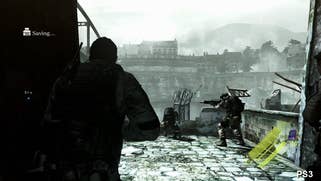
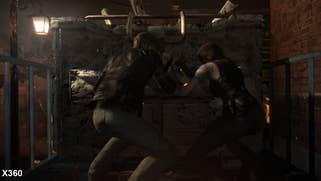
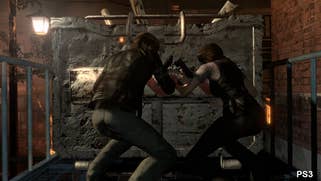
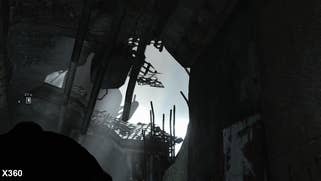
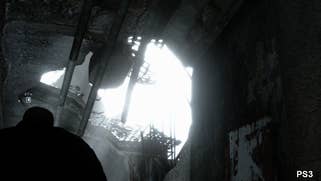


So as you can see, Capcom has handed in two very similar looking games here - and perhaps more illuminating comparisons are found by putting this game side by side with its predecessor. Here, in addition to the radically improved lighting and superior physics work, we see the inclusion of screen-space ambient occlusion (SSAO) in adding additional depth to the scene. Additionally, the utilisation of lower resolution transparencies on PS3 is now a thing of the past - both systems employ full-fat implementation for elements such as blur, smoke and particles. However, the move to a fully real-time lighting system does have its drawbacks: low resolution shadows are present on both consoles on many objects throughout the game, which are also poorly filtered, leading to some unsightly stair-stepping and blockiness being visible on these elements of the scene. A shadow off-set bias is also present, in which these elements protrude further outward on the 360 than they do on the PS3.
Resident Evil 6: Performance Analysis
The initial Xbox 360 demo of Resident Evil 6 was a cause for concern, with variable frame-rates and constant screen tearing impacting severely on the look and feel of the game. With the final retail release Capcom has managed to address some of these concerns: screen-tearing is no longer a problem and the improved image consistency that comes as a result of this helps to give the game a smoother, less jerky look during busy scenes in which the engine is being taxed.
In past MT Framework titles we saw both versions utilise different performance profiles: Capcom chose to use adaptive v-sync on the 360, where the game tears if frame-rate drops down below the 30FPS mark (in common with many games this generation), while on the PS3, v-sync is solidly maintained at the expense of overall performance, and with a significant impact on controller response.
For Resident Evil 6, Capcom has taken a different approach, which sees the gap in performance diminish dramatically, to the point where both versions are almost equal in almost all scenarios. There's the suggestion here that both versions are triple-buffered, which leads to the elimination of the constant tearing present in the 360 demo. The lack of screen tearing is certainly welcome in comparison to Resident Evil 5 on the Microsoft console, where torn frames would often creep into the centre of the screen in heated boss battles and demanding scenes. In that respect the complete lack of tearing is a huge benefit to owners of both platforms, but especially to those 360 owners who are particularly sensitive to this particular form of artifacting.
"There's no real performance advantage between the two platforms but the takeaway from our analysis is that generally speaking, RE6 could've been a smoother, more responsive experience."
However, despite the colossal improvement in image consistency, in terms of overall smoothness not much has really changed from when we looked at the 360 demo a while back. Performance is extremely variable, with the game largely failing to hold a steady frame-rate across a general run of play. The opening gameplay section represents something of a worst-case scenario: the action is situated in a city centre with lots of zombies on-screen. Draw distances are pretty large and environment detail is high. As a result we see smoothness fluctuate between 30FPS and down to as low as 18FPS in when fending off the hordes of enemies.
These fluctuations appear to affect general gameplay throughout both Leon and Chris's campaign, with frame-rates regularly hovering around the 20FPS mark in heated confrontations. Even where there is seemingly little going on the engine appears to have trouble hitting the 30FPS target with any degree of consistency. From what we gather, it appears that the heavy use of dynamic lighting (along with large numbers of light sources and increased environment detail) may be to blame, as we still see frequent drops in smoothness during a range of action-free scenarios.
Overall, Jake's sections tend to feature higher frame-rates than either Leon or Chris's, mainly due to the less hectic nature of the gameplay and combat encounters taking place in more enclosed spaces where draw distances are reduced. The first fight against Ustanak in a ruined building is a good example: the enclosed nature of the environment reduces the engine workload considerably and as a result the game regularly hits the desired 30FPS with ease. Dips in smoothness only occur during explosions or when multiple enemies on screen. Of course in busy scenes with lots of effects work and enemies, frame-rates do tend to drop back down again, although curiously during the second boss battle set in an Eastern European city we see a relatively stable 30FPS for prolonged periods in between heated gunfights in both Jake and Chris's campaigns.
"To illustrate the parity in performance, our analysis of engine-generated cut-scenes reveals almost identical frame-rates on both console platforms with only selected scenes seeing any deviation."
What is so surprising is just how close both versions perform taking in account the various gameplay scenarios and the load being put on the engine at any given point - particularly in scenes with lots of alpha-heavy effects work, where we previously saw the PS3 struggle to keep up with the 360. Taking into account fluctuations in performance caused by variances in gameplay (no two scenes are exactly like-for-like) frame-rate are basically a match, with certain scenes faring a little better on the 360, and vice-versa on the PS3 in other areas. Taking a look at the game's cut-sequences is even more revealing in this regard; both versions drop frames similarly throughout with neither one really gaining anything approaching a noteworthy advantage. It's really rare that we see a title with variable performance being quite so closely matched, but in this regard, Resident Evil 6 is quite remarkable: it's just a shame that frame-rates can vary so dramatically during gameplay.
Interestingly, despite the overall level of parity in performance, there are differences in how well each version feels to play. We found that head shots were a little easier to obtain on the PS3, and during the various QTEs (which require much flailing of the analogue sticks) we found it harder to keep up on the 360. Baseline input latency isn't so fantastic in this game - by default it's a little laggy, but across the run of play, it's the PS3 game that commands a marginal advantage.
Resident Evil 6: The Digital Foundry Verdict
Resident Evil 6 is a great piece of cross-platform conversion work, but Capcom's scattershot approach to the gameplay make-up doesn't really work out: three campaigns, each with the own unique focus on different gameplay elements - along with a fourth once these have been completed - leaves the overall experience feeling disjointed and rather uneven, with flashes of brilliance often followed by sections of mediocrity. More action and more content doesn't necessarily translate into a better game and in that sense we find that some of Leon's more tightly controlled sections offer some of the most enjoyable sections in the game.
But despite this, Resident Evil 6 features one notable improvement over previous games in the series, and past MT Framework engine games on the 360 and PS3 in general - there's really very little to tell these two titles apart. Performance is almost a complete match across both platforms, and the subtle differences in texture work and filtering only come to light in like-for-like comparison shots. The lighting model represents more of a curiosity - the variance in the position of light sources in both versions in some scenes tends to subjectively enhance the look of the PS3 game in many areas, although the 360 also seems to feature a scattering of more visually pleasing moments in some scenes too.
Where we do see a more noticeable change is in the control system, which feels slightly more sluggish on the 360 when both versions are performing at similar levels. Quite often it can be easier to aim more precisely on the PS3, and this does translate into a small but worthwhile gameplay advantage. That said, the difference isn't enough to discourage you from picking up either version of the game, although for gameplay soloists the PS3 game's slightly crisper response gives it the edge. With the co-op element once again enhancing the overall experience owners of both platforms would be wise to consider which online service they use the most in determining the final purchase.

